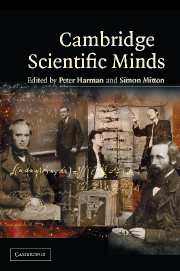Book contents
- Frontmatter
- Contents
- Foreword
- Introduction
- 1 William Gilbert
- 2 William Harvey
- 3 Isaac Newton: Creator of the Cambridge scientific tradition
- 4 William Whewell: A Cambridge historian and philosopher of science
- 5 Adam Sedgwick: A confident mind in turmoil
- 6 Charles Babbage: Science and reform
- 7 Charles Darwin
- 8 Stokes and Kelvin, Cambridge and Glasgow, light and heat
- 9 James Clerk Maxwell
- 10 The duo from Trinity: A.N. Whitehead and Bertrand Russell on the foundations of mathematics, 1895–1925
- 11 Thomson, Rutherford and atomic physics at the Cavendish
- 12 Hopkins and biochemistry
- 13 Charles Sherrington, E.D. Adrian, and Henry Dale: The Cambridge Physiological Laboratory and the physiology of the nervous system
- 14 Hardy and Littlewood
- 15 Arthur Stanley Eddington
- 16 Paul Dirac: A quantum genius
- 17 Alan Turing
- 18 Francis Crick and James Watson
- 19 Mary Cartwright
- 20 Joseph Needham
- 21 Molecular biology in Cambridge
- 22 The discovery of pulsars – prelude and aftermath
- 23 Stephen W. Hawking
11 - Thomson, Rutherford and atomic physics at the Cavendish
Published online by Cambridge University Press: 05 June 2014
- Frontmatter
- Contents
- Foreword
- Introduction
- 1 William Gilbert
- 2 William Harvey
- 3 Isaac Newton: Creator of the Cambridge scientific tradition
- 4 William Whewell: A Cambridge historian and philosopher of science
- 5 Adam Sedgwick: A confident mind in turmoil
- 6 Charles Babbage: Science and reform
- 7 Charles Darwin
- 8 Stokes and Kelvin, Cambridge and Glasgow, light and heat
- 9 James Clerk Maxwell
- 10 The duo from Trinity: A.N. Whitehead and Bertrand Russell on the foundations of mathematics, 1895–1925
- 11 Thomson, Rutherford and atomic physics at the Cavendish
- 12 Hopkins and biochemistry
- 13 Charles Sherrington, E.D. Adrian, and Henry Dale: The Cambridge Physiological Laboratory and the physiology of the nervous system
- 14 Hardy and Littlewood
- 15 Arthur Stanley Eddington
- 16 Paul Dirac: A quantum genius
- 17 Alan Turing
- 18 Francis Crick and James Watson
- 19 Mary Cartwright
- 20 Joseph Needham
- 21 Molecular biology in Cambridge
- 22 The discovery of pulsars – prelude and aftermath
- 23 Stephen W. Hawking
Summary
One discovery after another in the last few years of the nineteenth century initiated so radical a change in the nature of physical science that it has become customary to distinguish between ‘classical’ and ‘modern’ physics. It was, of course, no overnight change – most active investigators continued along the lines that had brought them success, and encouraged their students to follow their example. A few, notably Max Planck, caught a glimpse of a new world and did not much like it. As usual, it was the unfledged young who broke with tradition, like Einstein who saw clearly what Planck had hardly appreciated. The process can be seen in a brief look at the first few Cavendish Professors of Experimental Physics, beginning with James Clerk Maxwell who had died well before the critical date of 1895 when Röntgen announced the discovery of X-rays. His successor Lord Rayleigh (who stayed only five years) was already in the middle of an immensely productive research career. His versatile mind continued to find new applications of the well-tried methods until his death in 1919 at the age of seventy-six, having published seven papers in his last year. The fourth Cavendish Professor, Ernest Rutherford, arrived in Cambridge from New Zealand as a new research student in 1895 at the start of the revolution and quickly developed into the greatest experimenter of his time and the pioneer of a new branch of science, atomic and nuclear physics.
- Type
- Chapter
- Information
- Cambridge Scientific Minds , pp. 155 - 171Publisher: Cambridge University PressPrint publication year: 2002



